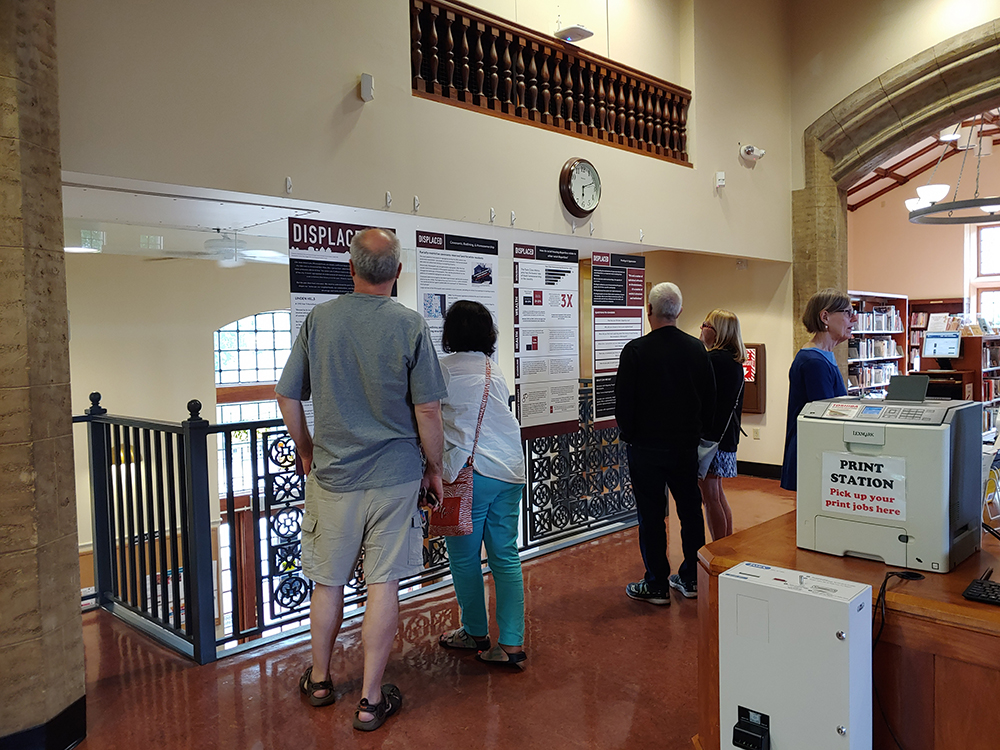Library exhibit explores Southwest’s history of racial displacement
By Zach Farber
Upstairs at the Linden Hills Library, a flat-screen television has been set up to serve as an interactive history exhibit. The screen displays an old hand-lettered, green-and-black map of Southwest Minneapolis. Scattered across the map are about a dozen big red dots, mostly clustered in the neighborhoods of Linden Hills and Lyndale.

Each dot represents the home of an African American family that lived in the area in the 1910s. A red dot for Willard M. Bugbee, a red dot for Harry and Clementine Robinson and a red dot for the family of Thomas West, an elevator operator who bought a house on Aldrich Avenue in 1908 and who the Twin City Star called “one of our most respected citizens.”
As visitors scroll down the TV screen and as the year turns from 1915 to 1920 to 1935, the red dots vanish from the map.
By 1940, black families had been entirely driven out of Linden Hills, the victims of white violence, racially restrictive housing covenants and discriminatory lending in government-backed mortgages. By 1960, Clyde and Daisy Edwards were the only black homeowners left in all of Southwest Minneapolis.
The interactive map is part of an exhibit called “Displaced,” on view at the library through July 11, which aims to illustrate “how racism reshaped settlement in Minneapolis.” Today, 75% of white Minneapolitans own homes compared with only 25% of black residents — the widest homeownership gap in any of the 100 American cities with the largest black populations.
The library exhibit expands on a show called “Owning Up: Racism and Housing in Minneapolis,” which opened last fall at the Hennepin History Museum. Co-curators Denise Pike and Maggie Mills, veterans of the University of Minnesota’s Mapping Prejudice project, said they hoped to tell the story with the new exhibit of how racist laws and practices have displaced not just African Americans but also Native Americans.
“There is a pattern of settler-colonialism and displacement of non-white people from areas to make land more valuable and appealing for white residents,” Pike said. “We wanted to show this was an on-going, long-term pattern.”
Pike and Mills compiled newspaper clippings, photographs, paintings and atlas pages to spell out the similarities between anti-black racism and the Minnesota Legislature’s decision to exile the region’s indigenous communities following the U.S.-Dakota War of 1862.
“Owning Up” told the story of the racist housing covenants that explicitly banned the sale of at least 20,000 Hennepin County homes to African Americans and members of other minority groups between 1910 and 1960. Mills said that some viewers wondered why the covenants did not include language banning indigenous people.
“What you’re seeing put into covenant language is the racial fears of that moment, and there wasn’t a racial fear of Native Americans because they had already been expelled,” she said. “This is the lineage of white supremacy.”
Four hanging panels in the exhibit give facts about the Dakota concentration camp that once stood near Fort Snelling, and about Minneapolis’ racial disparities and history of redlining and white violence, before prompting viewers to consider questions like “How has your life been shaped by race?” and “Why did you choose to live in your neighborhood?”
The exhibit suggests visitors learn more by reading books like Claudia Rankine’s Citizen or watching videos like the TPT documentary “Jim Crow of the North,” which will be shown at the library on July 11. When the exhibit ends, three of the hanging panels will travel to Washburn Library; a panel focused on Linden Hills will stay on permanently.
Pike, who graduated from the University of Minnesota this May with a master’s degree in heritage studies and public history, said her work detailing the Twin Cities’ history of racial displacement has been personally meaningful.
In 1993, when she was 4 years old, she lived in a St. Louis Park duplex with her white mother and her Nigerian father. Another African American family lived in the adjoining unit.
Pike was too young to remember the day when someone attempted to burn a cross on their garage but she still recalls “the tension and fear my parents had.” (The culprit was never caught.)
“This speaks to some of these incidents we see historically with racial housing discrimination,” she said. “Sometimes when there’s one African American family, it’s okay, but the moment another black family tries to move in, there’s this tide shifting and people get really motivated to try to expel these black families.”
Teresa Mercier, the supervisor of the Linden Hills Library, said she hopes the exhibit will get people thinking about how opportunities can be created for people of color to move into Linden Hills, which is currently about 88% white.
“People aren’t bad for living in Linden Hills,” she said, “but they need to understand that things have happened in the past to create the community we have today.”
Credits: Zac Farber | Southwest Journal
The post Library exhibit explores Southwest’s history of racial displacement appeared first on National Association of Real Estate Brokers.

